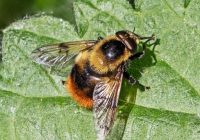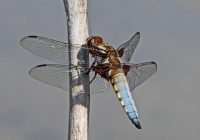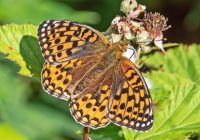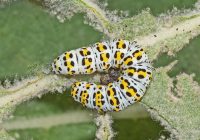Dr Phil Smith’s Wildlife Notes
June 2023
My May notes ended with “Surely June can’t be as dry as this, can it?” Well it was, for the first nine days, leaving our wonderful sand-dunes burnt brown. Thereafter, live-giving rain fell on ten days but only in small amounts. Met. Office maps showed we had about 75% of normal rainfall during the month. Nationally, it was the hottest June since records began and the sunniest since 1957.
These conditions had noticeable effects on sand-dune wildlife, with butterflies, day-flying moths and some hoverflies being in short supply until rain came later in the month. My first Meadow Brown, Ringlet and Narrow-bordered Five-spot Burnet were on 12th, while the first Gatekeeper appeared on 23rd, soon to become abundant, together with Meadow Browns. Many Gatekeepers were smaller than usual, suggesting that their grass-feeding caterpillars had struggled to find enough food. Luckily, some insects seemed oblivious to the dry conditions, especially the robberflies which like it hot. Thus, Trevor Davenport and I counted 15 Violet Black-legged Robberflies at Ainsdale NNR on 7th, while Pete Kinsella had as many as 22 the following day. I had only seen this distinctive creature once before at Hightown dunes in 2020. It is a mainly southern insect, whose northern limit is the Fylde coast. A close relative, the Striped-legged Robberfly, appeared on my flat window on 10th. Early in the month, most hoverflies were absent one exception being the Bumblebee Plumehorn, an excellent bumblebee mimic that comes in several varieties. The rare and colourful form haemorrhoidalis was new to me.
Although the water-table fell by about 10 cm during the month, most wetland plants survived. Southern sections of Birkdale Green Beach provided a wonderful display of marsh orchids, especially the Early Marsh-orchid of the endemic coastal sub-species coccinea, with its striking brick-red colouration. Later in the month, it was replaced by drifts of elegant Marsh Helleborines. Tim Rogers drew my attention to an unusually-marked orchid at Cabin Hill NNR. It looked like a Southern Marsh-orchid but with a more strongly-marked lip. It was probably a hybrid but the experts I contacted were perplexed. Two scrapes at Hightown retained shallow water, supporting several dragonflies including an obliging male Broad-bodied Chaser that perched for photos on a strategically positioned stick.
A visit to Ainsdale NNR on 9th with Trevor Davenport was rewarded with several dashing Dark Green Fritillaries and some resplendent Mullein Moth caterpillars on a plant of Great Mullein. I also came across a female Common Blue that had been caught by a spider. From photos, Richard Burkmar identified the latter as a Labyrinth Spider, a species that in common in southern England but becomes very local and mainly coastal in the Northwest.
When the rains came, hoverfly numbers began to pick up and I was delighted to find three Broad-banded Epistrophe on Wild Parsnip at Ravenmeols on 12th. This humbug-striped insect is widely distributed in Britain but more frequent in the north and west. The same day, I saw my first Small Skipper of the summer and a ‘true-bug’ called Closterotomus trivialis. The latter was new to the UK in 2009. It has rapidly spread through the country and there are now plenty of records in the region.
A visit to Freshfield Dune Heath Nature Reserve on 21st added several new species to the reserve list. A Dock Bugwas not unexpected but I was surprised to find Sea Rocket, Opium Poppy, Night-scented Stock and Annual Baby’s-breathon some disturbed ground, the last three being garden-escapes. A female Black-tailed Skimmer also attracted my attention but there were hardly any grasshoppers where large areas of grass had been burnt off by the drought.
On 29th, Trevor Davenport and I counted four shimmering-green Foresters nectaring on Ragwort at Ainsdale NNR’s Pinfold Meadow. Related to the burnets and declining nationally, these dazzling day-flying moths are just about hanging on at Ainsdale.
The strangest report of the month came from Ian Wolfenden. Having an interest in bird parasites, his friend hatched 18 Bird Blowflies from a Stonechat nest that Ian collected (after fledging) at Hightown dunes. The maggots are parasitic on chicks. Thinly distributed mainly in England, there are only two previous records of this blowfly for Sefton.
A real June highlight came on 19th when I made my way to Southport, following up a report by Jack Taylor of large numbers of Small Red-eyed Damselfliesat Victoria Park. He was right; I counted 43 singles and 38 pairs on the lake, totalling 100 individuals with their distinctive cherry-red eyes. Since the first for Britain in 1999, this damselfly has rocketed north, reaching Merseyside in 2019; one of a host of insects responding to climate change.






